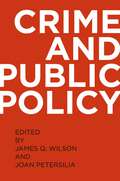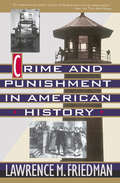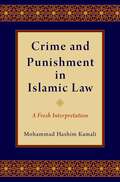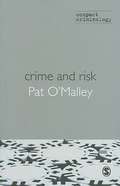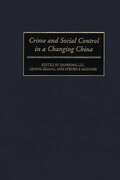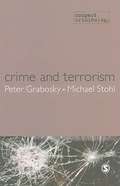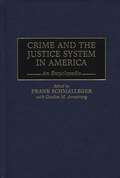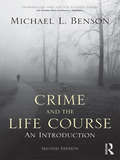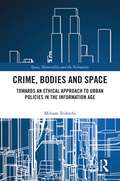- Table View
- List View
Crime and Public Policy
Crime in the United States has fluctuated considerably over the past thirty years, as have the policy approaches to deal with it. During this time criminologists and other scholars have helped to shed light on the role of incarceration, prevention, drugs, guns, policing, and numerous other aspects to crime control. Yet the latest research is rarely heard in public discussions and is often missing from the desks of policymakers. This book accessibly summarizes the latest scientific information on the causes of crime and evidence about what does and does not work to control it. Thoroughly revised and updated, this new version of Crime and Public Policy will include twenty chapters and five new substantial entries. As with previous editions, each essay reviews the existing literature, discusses the methodological rigor of the studies, identifies what policies and programs the studies suggest, and then points to policies now implemented that fail to reflect the evidence. The chapters cover the principle institutions of the criminal justice system (juvenile justice, police, prisons, probation and parole, sentencing), how broader aspects of social life inhibit or encourage crime (biology, schools, families, communities), and topics currently generating a great deal of attention (criminal activities of gangs, sex offenders, prisoner reentry, changing crime rates). With contributions from trusted, leading scholars, Crime and Public Policy offers the most comprehensive and balanced guide to how the latest and best social science research informs the understanding of crime and its control for policymakers, community leaders, and students of crime and criminal justice.
Crime And Punishment: Offenders And Victims In A Broken Justice System (Redback Ser. #5)
by Russell MarksIf the goal of our justice system is to reduce crime and create a safer society, then we must do better.According to conventional wisdom, severely punishing offenders reduces the likelihood that they'll offend again. Why, then, do so many who go to prison continue to commit crimes after their release? What do we actually know about offenders and the reasons they break the law?In Crime & Punishment, Russell Marks argues that the lives of most criminal offenders - and indeed of many victims of crime - are marked by often staggering disadvantage. For many offenders, prison only increases their chances of committing further crimes. And despite what some media outlets and politicians want us to believe, harsher sentences do not help most victims to heal. Drawing on his experience as a lawyer, Marks eloquently makes the case for restorative justice and community correction, whereby offenders are obliged to engage with victims and make amends. Crime & Punishment is a provocative call for change to a justice system in desperate need of renewal. 'This book is for anyone who despairs at the current system. But more importantly, it is for those who think punishment is the answer.' -the Age'A reflective, well-argued book...what makes it even more compelling is Marks also offers suggestions on a different (better) system of crime and punishment.' -Sydney Morning HeraldRussell Marks is the author of Crime and Punishment. He has worked as a criminal defence lawyer and academic and as a writer for the Monthly. He is currently a policy advisor to the Greens and an honorary associate at La Trobe University.
Crime And Punishment In American History
by Lawrence FriedmanIn a panoramic history of our criminal justice system from Colonial times to today, one of our foremost legal thinkers shows how America fashioned a system of crime and punishment in its own image.
Crime And Punishment In Contemporary Culture (International Library Of Sociology Ser.)
by Claire ValierCrime and Punishment in Islamic Law: A Fresh Interpretation
by Mohammad Hashim KamaliIn Crime and Punishment in Islamic Law: A Fresh Interpretation, Mohammad Kamali considers problems associated with and proposals for reform of the hudud punishments prescribed by Islamic criminal law, and other topics related to crime and punishment in Shariah. He examines what the Qur'an and hadith say about hudud punishments, as well as just retaliation (qisas), and discretionary punishments (ta'zir), and looks at modern-day applications of Islamic criminal law in 15 Muslim countries. Particular attention is given to developments in Malaysia, a multi-religious society, federal state, and self-described democracy, where a lively debate about hudud has been on-going for the last three decades. Malaysia presents a particularly interesting case study of how a reasonably successful country with a market economy, high levels of exposure to the outside world, and a credible claim to inclusivity, deals with Islamic and Shariah-related issues. Kamali concludes that there is a significant gap between the theory and practice of hudud in the scriptural sources of Shariah and the scholastic articulations of jurisprudence of the various schools of Islamic law, arguing that literalism has led to such rigidity as to make Islamic criminal law effectively a dead letter. His goal is to provide a fresh reading of the sources of Shariah and demonstrate how the Qur'an and Sunnah can show the way forward to needed reforms of Islamic criminal law.
Crime and Punishment in Islamic Law: A Fresh Interpretation
by Mohammad Hashim KamaliIn Crime and Punishment in Islamic Law: A Fresh Interpretation, Mohammad Kamali considers problems associated with and proposals for reform of the hudud punishments prescribed by Islamic criminal law, and other topics related to crime and punishment in Shariah. He examines what the Qur'an and hadith say about hudud punishments, as well as just retaliation (qisas), and discretionary punishments (ta'zir), and looks at modern-day applications of Islamic criminal law in 15 Muslim countries. Particular attention is given to developments in Malaysia, a multi-religious society, federal state, and self-described democracy, where a lively debate about hudud has been on-going for the last three decades. Malaysia presents a particularly interesting case study of how a reasonably successful country with a market economy, high levels of exposure to the outside world, and a credible claim to inclusivity, deals with Islamic and Shariah-related issues. Kamali concludes that there is a significant gap between the theory and practice of hudud in the scriptural sources of Shariah and the scholastic articulations of jurisprudence of the various schools of Islamic law, arguing that literalism has led to such rigidity as to make Islamic criminal law effectively a dead letter. His goal is to provide a fresh reading of the sources of Shariah and demonstrate how the Qur'an and Sunnah can show the way forward to needed reforms of Islamic criminal law.
Crime And Punishment: Offenders And Victims In A Broken Justice System (Redback Ser. #5)
by Russell MarksIf the goal of our justice system is to reduce crime and create a safer society, then we must do better.According to conventional wisdom, severely punishing offenders reduces the likelihood that they'll offend again. Why, then, do so many who go to prison continue to commit crimes after their release? What do we actually know about offenders and the reasons they break the law?In Crime & Punishment, Russell Marks argues that the lives of most criminal offenders - and indeed of many victims of crime - are marked by often staggering disadvantage. For many offenders, prison only increases their chances of committing further crimes. And despite what some media outlets and politicians want us to believe, harsher sentences do not help most victims to heal. Drawing on his experience as a lawyer, Marks eloquently makes the case for restorative justice and community correction, whereby offenders are obliged to engage with victims and make amends. Crime & Punishment is a provocative call for change to a justice system in desperate need of renewal. 'This book is for anyone who despairs at the current system. But more importantly, it is for those who think punishment is the answer.' -the Age'A reflective, well-argued book...what makes it even more compelling is Marks also offers suggestions on a different (better) system of crime and punishment.' -Sydney Morning HeraldRussell Marks is the author of Crime and Punishment. He has worked as a criminal defence lawyer and academic and as a writer for the Monthly. He is currently a policy advisor to the Greens and an honorary associate at La Trobe University.
Crime and Risk (PDF)
by Pat O'Malley'O'Malley, in this beautifully simple, insightful and erudite book, locates risk within a variety of mentalities that have been, and are being, deployed to govern crime - in doing so he places risk, where it should be, at the very centre of criminological thought and practice. This is an important book.' - Clifford Shearing, Centre of Criminology, Faculty of Law, University of Cape Town. Over recent years, the governance of crime - from policing and crime prevention to sentencing and prison organization - has moved away from a focus on reforming offenders toward preventing crime and managing behaviour using predictive and distributional (such as risk) techniques. Crime and Risk presents an engaging discussion of risk strategies and risk-taking in the domain of crime and criminal justice. It outlines the broad theoretical issues and political approaches involved, relating risk in contemporary crime governance to risk in criminal activity. Taking a broad and discursive approach, it covers: nbsp; Risk-taking and contemporary culture nbsp; The excitement associated with risk-taking and the impact of criminal activity The application of risk-oriented developments in crime prevention and control nbsp; The use of genetic and related biotechnologies to assess and react to perceived threats The conceptualization of risk in relation to race and gender The influence of excitement upon criminal activity Evidence and accountability 'Pat O'Malley's approach to risk, crime and criminal justice is stimulating and provocative. He points out that in criminology risk is seen almost entirely in negative terms, in marked contrast to other social spheres, where risk is regarded much more positively, as for example in business innovation and entrepreneurship. O'Malley says that risk-taking is an aspect of criminal behaviour that is generally overlooked by criminology, and directs his readers' attention to Katz and to the cultural criminologists who look at risk-taking as a source of excitement for offenders. O'Malley's highly original 'risky criminology' reconnects risk with criminological theory, and challenges those concerned with punishment and crime prevention to develop constructive, imaginative measures and strategies concerned with the reducing harm caused by criminal and anti-social risk-taking behaviour rather than trying to control risk through repression and exclusion. ' - Barbara Hudson, Professor of Law, University of Central Lancashire.
Crime and Security
by Benjamin GooldThe pursuit of security is now central to the development of public policy and a driving force behind the spread of private policing. Just as new theoretical frameworks are needed to deal with the increasing tendency of crime control policies to focus on risk reduction, new forms of governance are also required to deal with the rapid growth of the private security industry. This volume brings together a wide range of contributions from leading scholars in the field and includes international and comparative perspectives on the challenges posed by the rise of the 'security society'.
Crime and Security
by Benjamin Goold Lucia ZednerThe pursuit of security is now central to the development of public policy and a driving force behind the spread of private policing. Just as new theoretical frameworks are needed to deal with the increasing tendency of crime control policies to focus on risk reduction, new forms of governance are also required to deal with the rapid growth of the private security industry. This volume brings together a wide range of contributions from leading scholars in the field and includes international and comparative perspectives on the challenges posed by the rise of the 'security society'.
Crime and Social Control in a Changing China (Contributions in Criminology and Penology)
This important edited collection of articles by both Chinese and American scholars attempts to promote a more accurate and in-depth understanding of crime and social control in China, as it undergoes significant cultural, economic, and social change. The editors contend that as the economic system has been transformed, many other social institutions in China have also experienced unprecedented changes, including legal institutions and other organizations responsible for social control. The essays focus on crime in China and summarize the major structural changes in Chinese society and their effects on crime and justice over the last ten to fifteen years, offer an overview of Chinese perspectives on crime, examine socio-economic changes and their impact on social control, and discuss changes in adults' and children's courts and the new changes in Chinese policing in Chinese society.Organized into four parts, this work addresses the nature, extent and special features of crime and delinquency in China under conditions of social change. It also investigates the question of the social correlation of changing patterns of crime. The impact of social transition on the changes in the grassroots level of social control is also discussed. Chinese law and criminal justice, with particular focus on the courts, police, and crime prevention are mentioned as well. This unique collection of essays is a timely and significant contribution to the fields of comparative criminology, social control, Chinese studies, and legal studies.
Crime and Technology: New Frontiers for Regulation, Law Enforcement and Research
by Ernesto U. SavonaGuido Rossi As Chairman of ISPAC, I want to thank all the contributors to this book that originates from the International Conference on Crime and Technology. This could be the end of my presentation if I did not feel uneasy not considering one of the problems I believe to be pivotal in the relationship between crime and technology. I shall also consider that the same relationship exists between terror and globalization, while globalization is stemming from technology and terror from crime. Transnational terrorism is today made possible by the vast array of communication tools. But the paradox is that if globalization facilitates terrorist violence, the fight against this war without borders is potentially disastrous for both economic development and globalization. Antiterrorist measures restrict mobility and financial flows, while new terrorist attacks could lead the way for an antiglobalist reaction. But the global society has yet to agree on a common definition of terrorism or on a common policy against it. The ordinary traditional criminal law is still depending on the sovereignty of national states, while international criminal justice is only a spotty and contested last resort. The fragmented and weak international institutions and underdeveloped civil societies have no power to enforce criminal justice against t- rorism. At the same time, the states that are its targets have no interest in applying the laws of war (the Geneva Conventions) to their fight against terrorists.
Crime and Terrorism (PDF)
by Peter N. GraboskyTerrorism and crime are two areas of knowledge that have traditionally been looked at independently. In this timely and original text, two of the leading authors in the field provide a clear and thorough look at terrorism from a criminological perspective. Integrating the latest research, the book explores the motives of criminals and terrorists, the causes of crime and terrorism and the impact of the law and the legal system. Central to this exploration, the authors examine the nexus between criminal and terrorist organizations, and the commonalities and differences between them and what this means for public policy and safety and security within states. Cross-cultural and international in perspective, this is a fresh and original text that will appeal to undergraduates, academics, and researchers in criminology, politics, international relations, sociology, communication and cultural studies.
Crime and the Construction of Forensic Objectivity from 1850: Space, Media, Experts And Ethics (Palgrave Histories of Policing, Punishment and Justice)
by Alison AdamThis book charts the historical development of 'forensic objectivity' through an analysis of the ways in which objective knowledge of crimes, crime scenes, crime materials and criminals is achieved. Taking an interdisciplinary approach, with authors drawn from law, history, sociology and science and technology studies, this work shows how forensic objectivity is constructed through detailed crime history case studies, mainly in relation to murder, set in Scotland, England, Germany, Sweden, USA and Ireland. Starting from the mid-nineteenth century and continuing to the present day, the book argues that a number of developments were crucial. These include: the beginning of crime photography, the use of diagrams and models specially constructed for the courtroom so jurors could be ‘virtual witnesses’, probabilistic models of certainty, the professionalization of medical and scientific expert witnesses and their networks, ways of measuring, recording and developing criminal records and the role of the media, particularly newspapers in reporting on crime, criminals and legal proceedings and their part in the shaping of public opinion on crime. This essential title demonstrates the ways in which forensic objectivity has become a central concept in relation to criminal justice over a period spanning 170 years.
Crime and the Justice System in America: An Encyclopedia (Non-ser.)
by Gordon M. Armstrong Frank SchmallegerAn inter-disciplinary survey of crime and violence in America with historical perspective, but primary entry emphasis focused on the 20th century. Addressing specifically the period from 1960 to the present, this reference also projects into the 21st century with contemporary terminology covering aspects of violent crime, DNA evidence, terrorism, riots, gangs, guns and gun control, AIDS, drug and drug related crime, and corporate and political crime. A Bibliographic Essay, Table of Cases, and Index enrich this work designed for students, scholars, and professionals in criminal justice and related fields.
Crime and the Life Course
by Michael BensonIn recent years, the lifecourse perspective has become a popular theoretical orientation toward crime. Yet despite its growing importance in the field of criminology, most textbooks give it only cursory treatment. Crime and the Lifecourse: An Introduction by Michael L. Benson provides a comprehensive overview of contemporary research and theory on the life-course approach to crime. The book emphasizes a conceptual understanding of this approach. A special feature is the integration of qualitative and quantitative research on criminal life histories. This book: provides an overview of the life course approach and describes the major concepts and issues in lifecourse theory as it applies to criminology reviews evidence on biological and genetic influences on crime reviews research on the role of the family in crime and juvenile delinquency provides a detailed discussion of the criminological lifecourse theories of Moffitt, Hagan, Sampson and Laub, and others discusses the connections between youthful crime and adult outcomes in education, occupation, and marriage presents an application of the lifecourse approach to white-collar crime discusses how macro sociological and historical developments have influenced the shape of the lifecourse in American society as it relates to patterns in crime.
Crime and the Life Course
by Michael BensonIn recent years, the lifecourse perspective has become a popular theoretical orientation toward crime. Yet despite its growing importance in the field of criminology, most textbooks give it only cursory treatment. Crime and the Lifecourse: An Introduction by Michael L. Benson provides a comprehensive overview of contemporary research and theory on the life-course approach to crime. The book emphasizes a conceptual understanding of this approach. A special feature is the integration of qualitative and quantitative research on criminal life histories. This book: provides an overview of the life course approach and describes the major concepts and issues in lifecourse theory as it applies to criminology reviews evidence on biological and genetic influences on crime reviews research on the role of the family in crime and juvenile delinquency provides a detailed discussion of the criminological lifecourse theories of Moffitt, Hagan, Sampson and Laub, and others discusses the connections between youthful crime and adult outcomes in education, occupation, and marriage presents an application of the lifecourse approach to white-collar crime discusses how macro sociological and historical developments have influenced the shape of the lifecourse in American society as it relates to patterns in crime.
Crime, Bodies and Space: Towards an Ethical Approach to Urban Policies in the Information Age
by Miriam TedeschiWith cities increasingly following rigid rules for designing out crime and producing spaces under surveillance, this book asks how information shapes bodies, space, and, ultimately, policymaking. In recent years, public spaces have changed in Western countries, with the urban realm becoming an ever-more monitored, privatised, homogeneous, and aseptic space that has lost its character, uniqueness, and diversity in the name of ‘security’. This underpins precise moral and political choices in terms of what a space should be, how it can be used, and by whom. These choices generate material consequences concerning urban inequality and freedom, or otherwise, of movement. Based on ethnographic and autoethnographic explorations in London’s ‘criminal’ spaces, this book illustrates how rules, policies, and moral values, far from being abstract concepts, are in fact material. Outlining the basis of a new urban information ethics, the book both exposes and challenges how moral values and predefined categories are applied to, and materially shape, the movement of bodies in urban space with regard to crime and security policies. Drawing on Gilbert Simondon’s information theory and a wide range of work in urban studies, geography, and planning, as well as in surveillance studies, object-oriented ontology, and contemporary theoretical work on both materiality and affect, the book provides a radically new perspective on urban space in general, and crime and security in particular. This book uses a balanced mix of theoretical concepts and empirical study to bring theory and practice together in an intertwining of ethnography and autoethnography.This book will be of interest to students and scholars in the fields of urban studies, urban geography, sociology, surveillance studies, legal theory, socio-legal studies, planning law, environmental law, and land law.
Crime, Bodies and Space: Towards an Ethical Approach to Urban Policies in the Information Age
by Miriam TedeschiWith cities increasingly following rigid rules for designing out crime and producing spaces under surveillance, this book asks how information shapes bodies, space, and, ultimately, policymaking. In recent years, public spaces have changed in Western countries, with the urban realm becoming an ever-more monitored, privatised, homogeneous, and aseptic space that has lost its character, uniqueness, and diversity in the name of ‘security’. This underpins precise moral and political choices in terms of what a space should be, how it can be used, and by whom. These choices generate material consequences concerning urban inequality and freedom, or otherwise, of movement. Based on ethnographic and autoethnographic explorations in London’s ‘criminal’ spaces, this book illustrates how rules, policies, and moral values, far from being abstract concepts, are in fact material. Outlining the basis of a new urban information ethics, the book both exposes and challenges how moral values and predefined categories are applied to, and materially shape, the movement of bodies in urban space with regard to crime and security policies. Drawing on Gilbert Simondon’s information theory and a wide range of work in urban studies, geography, and planning, as well as in surveillance studies, object-oriented ontology, and contemporary theoretical work on both materiality and affect, the book provides a radically new perspective on urban space in general, and crime and security in particular. This book uses a balanced mix of theoretical concepts and empirical study to bring theory and practice together in an intertwining of ethnography and autoethnography.This book will be of interest to students and scholars in the fields of urban studies, urban geography, sociology, surveillance studies, legal theory, socio-legal studies, planning law, environmental law, and land law.
Crime, Broadsides and Social Change, 1800-1850
by Kate BatesThis book explores the form, function and meaning of crime and execution broadsides printed in nineteenth-century Britain. By presenting a detailed discourse analysis of 650 broadsides printed across Britain between the years 1800-1850, this book provides a unique and alternative interpretation as to their narratives of crime. This criminological interpretation is based upon the social theories of Emile Durkheim, who recognised the higher utility of crime and punishment as being one of social integration and the preservation of moral boundaries. The central aim of this book is to show that broadsides relating to crime and punishment served as a form of moral communication for the masses and that they are examples of how the working class once attempted to bolster a sense of stability and community, during the transitional years of the early nineteenth century, by effectively representing both a consolidation and celebration of their core values and beliefs.
Crime, Criminal Justice, and the Evolving Science of Criminology in South Asia: India, Pakistan, and Bangladesh (Palgrave Advances in Criminology and Criminal Justice in Asia)
by Shahid M. ShahidullahWritten by some of the most notable criminologists of South Asia, this book examines advances in law, criminal justice, and criminology in South Asia with particular reference to India, Pakistan, and Bangladesh. The edited collection explores, on the basis of surveys, interviews, court records, and legislative documents, a wide range of timely issues such as: the impacts of modernization and globalization on laws combating violence against women and children, evolution of rape laws and the issues of gender justice, laws for combating online child sexual abuse, transformation in juvenile justice, integration of women into policing, the dynamics of violence and civility, and the birth of colonial criminology in South Asia. Students of criminology and criminal justice, practitioners, policy-makers, and human rights advocates will find this distinctive volume highly valuable.
Crime, Criminal Justice and the Probation Service (Routledge Revivals)
by Robert HarrisFirst published in 1992, Crime, Criminal Justice and the Probation Service is a thought-provoking analysis of the role of the probation service in developing an integrated system of criminal justice. Robert Harris provides readable information about our knowledge of such areas as criminal statistics, victims, fear of crime and crime prevention. He also explores the treatment of women and ethnic minorities by the criminal justice system, the question of a sentencing council and the future of community corrections. A central theme is that all the professionals involved in the criminal justice system must work more closely together so that the mistakes of the past can be avoided in the future. The book therefore has a wide appeal not only to probation officers and social workers, but also to criminal justice professionals and administrators, including the police and the legal profession.
Crime, Criminal Justice and the Probation Service (Routledge Revivals)
by Robert HarrisFirst published in 1992, Crime, Criminal Justice and the Probation Service is a thought-provoking analysis of the role of the probation service in developing an integrated system of criminal justice. Robert Harris provides readable information about our knowledge of such areas as criminal statistics, victims, fear of crime and crime prevention. He also explores the treatment of women and ethnic minorities by the criminal justice system, the question of a sentencing council and the future of community corrections. A central theme is that all the professionals involved in the criminal justice system must work more closely together so that the mistakes of the past can be avoided in the future. The book therefore has a wide appeal not only to probation officers and social workers, but also to criminal justice professionals and administrators, including the police and the legal profession.
Crime, Critique and Utopia (Critical Criminological Perspectives)
by Margaret Malloch Bill MunroThis book explores the relevance of utopia in relation to contemporary criminology. The range of contributors explore the application of a utopian method for uncovering the potential within criminology and criminal justice, as well as the relevance of the utopian impulse for developing a challenge to the status quo in academia and beyond.
Crime, Desire and Law's Unconscious: Law, Literature and Culture
by David GurnhamSexual desire, and the possible dangers associated with its more extreme manifestations, provokes strong, albeit often contradictory reactions. Such reactions are a well-known stimulant of creative, juridical and scholarly activity, and the texts of law, literature and academic criticism respond to it in ways that suggest both of revulsion and fascination. But how are we to understand such responses, and what can they tell us about the relationship between law and its‘others’? Exploring these questions in the context of HIV transmission, on-street sexual exploitation and erotic asphyxiation, this book draws on psychoanalytic theory in order to understand the motivations behind legal, literary and cultural constructions of sexual offences, their perpetrators and victims. Its analysis of these constructions in a diverse range of sources - including appeal judgments in England & Wales and North America, criminal trials and their reporting, visual and linguistic cultures and both modern and ‘classical’ literature – will be of great interest to legal theorists and socio-legal scholars, as well as those with relevant concerns in the fields of literature and cultural studies.
